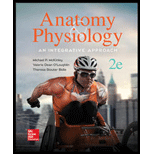
Anatomy & Physiology: An Integrative Approach
2nd Edition
ISBN: 9780078024283
Author: Michael McKinley Dr., Valerie O'Loughlin, Theresa Bidle
Publisher: McGraw-Hill Education
expand_more
expand_more
format_list_bulleted
Concept explainers
Question
Chapter 11, Problem 7DYKB
Summary Introduction
Introduction:
Muscle is defined as the soft tissue found in animals and humans. There are three types of muscles such as striated muscle, non-striated and cardiac muscle. Muscle is composed of actin and myosin protein filaments that slide into one another and cause contraction of the muscle. It helps to produce force and motion.
Expert Solution & Answer
Want to see the full answer?
Check out a sample textbook solution
Students have asked these similar questions
Other than oil and alcohol, are there other liquids you could compare to water (that are liquid at room temperature)?
How is water unique compared to these other liquids?
What follow-up experiment would you like to do, and how would you relate it to your life?
Selection of Traits
What adaptations do scavengers have for locating and feeding on prey?
What adaptations do predators have for capturing and consuming prey?
Competition Between Species
What natural processes limit populations from growing too large?
What are some resources organisms can compete over in their natural habitat?
Chapter 11 Solutions
Anatomy & Physiology: An Integrative Approach
Ch. 11.1 - What is the difference between the origin and...Ch. 11.1 - Which muscle is strongera pennate muscle or a...Ch. 11.1 - What is the difference between an agonist and a...Ch. 11.2 - What are some words used in muscle names that...Ch. 11.2 - The gluteus maximus muscle gets its name from...Ch. 11.3 - Prob. 6WDYLCh. 11.3 - Prob. 7WDYLCh. 11.3 - Which extrinsic eye muscles abduct the eye (move...Ch. 11.3 - Prob. 9WDYLCh. 11.3 - Prob. 10WDYL
Ch. 11.3 - List the four suprahyoid muscles, and describe a...Ch. 11.3 - Which neck muscles extend the neck? Which neck...Ch. 11.4 - Which muscles form the erector spinae, and what...Ch. 11.5 - Prob. 14WDYLCh. 11.5 - How is the diaphragm involved in respiration?Ch. 11.6 - What are the main actions of the abdominal...Ch. 11.7 - Prob. 17WDYLCh. 11.8 - Prob. 18WDYLCh. 11.8 - Prob. 19WDYLCh. 11.8 - Identify the rotator cuff muscles, and describe...Ch. 11.8 - What are the muscles in the anterior compartment...Ch. 11.8 - Prob. 22WDYLCh. 11.8 - Prob. 23WDYLCh. 11.8 - What muscles in the posterior compartment move the...Ch. 11.8 - Prob. 25WDYLCh. 11.9 - Prob. 26WDYLCh. 11.9 - Prob. 27WDYLCh. 11.9 - Prob. 28WDYLCh. 11.9 - Prob. 29WDYLCh. 11 - _____ 1. Which statement is true about an agonist?...Ch. 11 - Prob. 2DYKBCh. 11 - _____ 3. When this large muscle contracts, the...Ch. 11 - Prob. 4DYKBCh. 11 - _____ 5. Each of these muscles can flex the...Ch. 11 - _____ 6. The dorsal interossei muscles in the hand...Ch. 11 - Prob. 7DYKBCh. 11 - Prob. 8DYKBCh. 11 - Prob. 9DYKBCh. 11 - Prob. 10DYKBCh. 11 - Prob. 11DYKBCh. 11 - Which muscles of facial expression do you use to...Ch. 11 - Distinguish between suprahyoid and infrahyoid...Ch. 11 - What is the effect of contracting the abdominal...Ch. 11 - What movements are possible at the glenohumeral...Ch. 11 - Identify the compartments of the arm (brachium),...Ch. 11 - Prob. 17DYKBCh. 11 - Prob. 18DYKBCh. 11 - What leg muscles allow a ballet dancer to rise up...Ch. 11 - Which muscles are responsible for foot inversion?Ch. 11 - Prob. 1CALCh. 11 - Prob. 2CALCh. 11 - Prob. 3CALCh. 11 - Prob. 4CALCh. 11 - Prob. 5CALCh. 11 - Prob. 1CSLCh. 11 - While training on the balance beam, Pat slipped...Ch. 11 - Prob. 3CSLCh. 11 - Why is it more difficult for Eric to lift a heavy...
Knowledge Booster
Learn more about
Need a deep-dive on the concept behind this application? Look no further. Learn more about this topic, biology and related others by exploring similar questions and additional content below.Similar questions
- Species Interactions Explain how predators, prey and scavengers interact. Explain whether predators and scavengers are necessary or beneficial for an ecosystem.arrow_forwardmagine that you are conducting research on fruit type and seed dispersal. You submitted a paper to a peer-reviewed journal that addresses the factors that impact fruit type and seed dispersal mechanisms in plants of Central America. The editor of the journal communicates that your paper may be published if you make ‘minor revisions’ to the document. Describe two characteristics that you would expect in seeds that are dispersed by the wind. Contrast this with what you would expect for seeds that are gathered, buried or eaten by animals, and explain why they are different. (Editor’s note: Providing this information in your discussion will help readers to consider the significance of the research).arrow_forwardWhat is the difference between Uniporters, Symporters and Antiporters? Which of these are examples of active transport?arrow_forward
- What are Amyloid Fibrils? What biological functions are these known to perform?arrow_forwardHow do histamine and prostaglandins help in the mobilization of leukocytes to an injury site? What are chemotactic factors? How do they affect inflammation process?arrow_forwardCompare and contrast neutrophils and macrophages. Describe two ways they are different and two ways they are similar.arrow_forward
- Describe the effects of three cytokines (not involved in the initial inflammation response). What cells release them?arrow_forwardDescribe activation of helper T cells or cytotoxic T cellsarrow_forwardCompare and contrast MHC 1 and MHC 2. Describe two way they are different and two ways they similar including how they are used in antigen presentation.arrow_forward
arrow_back_ios
SEE MORE QUESTIONS
arrow_forward_ios
Recommended textbooks for you
 Fundamentals of Sectional Anatomy: An Imaging App...BiologyISBN:9781133960867Author:Denise L. LazoPublisher:Cengage Learning
Fundamentals of Sectional Anatomy: An Imaging App...BiologyISBN:9781133960867Author:Denise L. LazoPublisher:Cengage Learning


Fundamentals of Sectional Anatomy: An Imaging App...
Biology
ISBN:9781133960867
Author:Denise L. Lazo
Publisher:Cengage Learning

Types of Human Body Tissue; Author: MooMooMath and Science;https://www.youtube.com/watch?v=O0ZvbPak4ck;License: Standard YouTube License, CC-BY